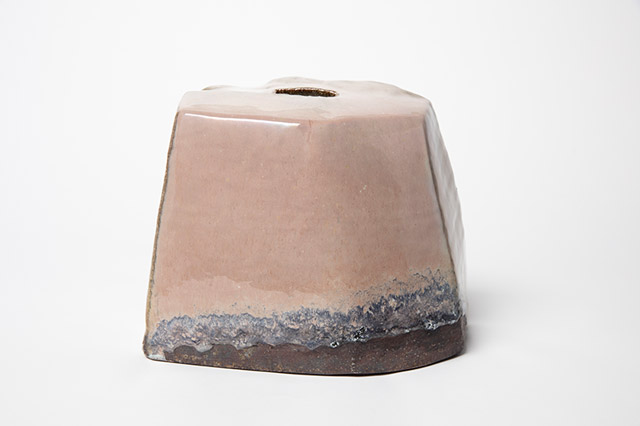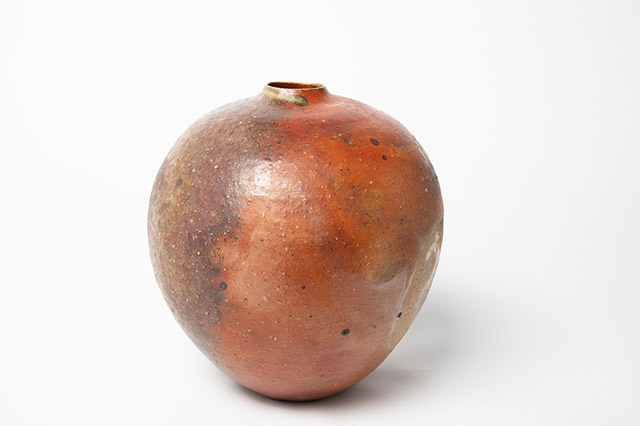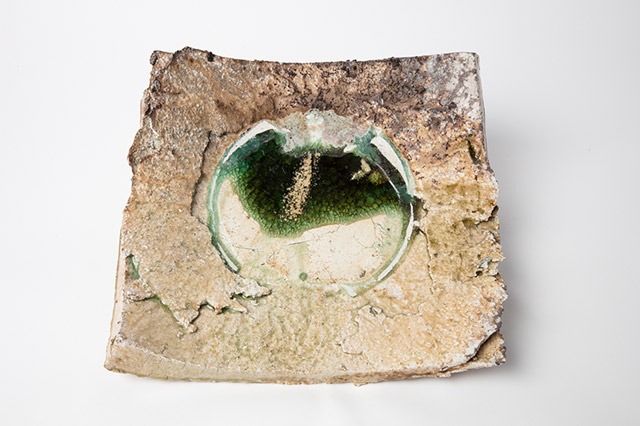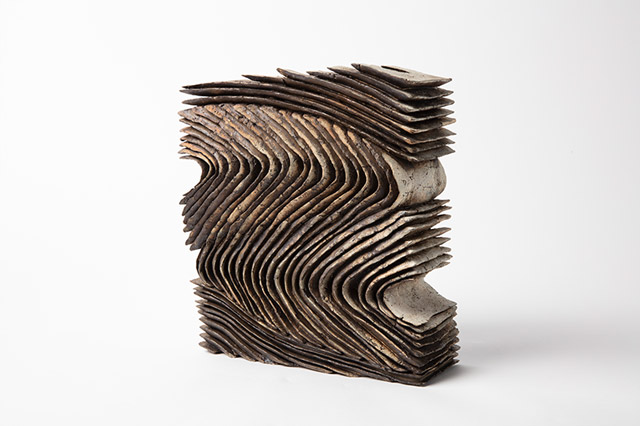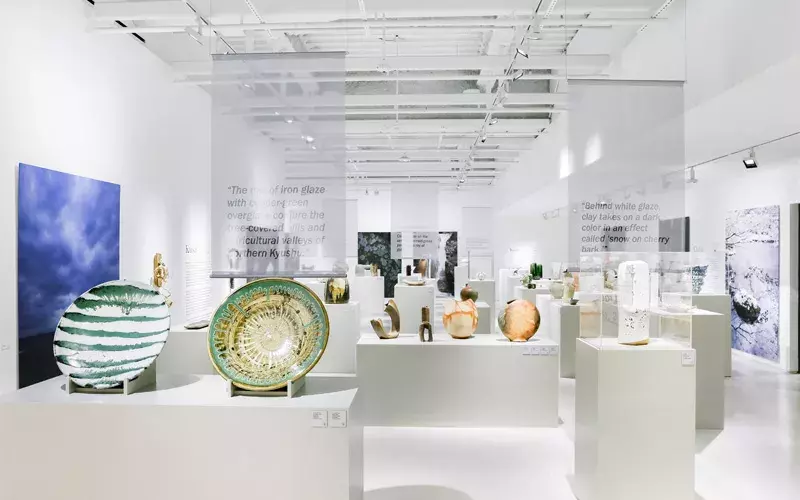
- Date
04.17.2019 – 06.20.2019
- Mon. - Sat.
10:00 AM – 8:00 PM
- Sun.
10:00 AM – 7:00 PM
- Location
JAPAN HOUSE Gallery, Level 2
- Fee
Complimentary
For centuries, Japanese artists and collectors have welcomed the natural imperfections that emerge on ceramic vessels during the firing process. These pools of glaze, scorch markings, cracks and indentations are referred to as the keshiki (‘landscapes’) of a piece, and since the sixteenth century have been celebrated as adding new beauty, depth, and value to the work. In Japanese, “admiring the keshiki” has evolved into a particular way of looking at ceramics. While Japanese ceramics have enticed collectors around the world, one Southern Californian, Gordon Brodfuehrer, has built an exceptional collection that includes styles and techniques from kilns across Japan. KESHIKI |The Landscape Within presents over sixty contemporary ceramic pieces from the Brodfuehrer collection, inviting visitors to join this pioneering collector in his journey around Japan.
While pottery-making culture in Japan is one of the oldest in the world going back to roughly 10,000BCE, the history of the six most renowned kiln sites—Bizen, Seto, Tokoname, Shigaraki, Tanba, and Echizen—can be traced back to at least the 12th or 13th centuries. The works in this exhibition are arranged in approximate geographical order of their origins in Japan, from west to east, and indicate how local clay characteristics and ancient traditions continue to assert themselves in contemporary ceramic design. For example, Jōji Yamashita’s contemporary vases and jars utilize the Bizen technique of wrapping rice straw from local agricultural fields around vessels in order to produce warm orange striations against the clay. Yasuhiro Kohara uses the rough texture of Shigaraki clay, with feldspar stones bursting from its skin, as well as traditional glazing techniques, to achieve his eclectic forms.
Ceramic art is an integral part of everyday life in Japan. While Western collectors enjoy larger and bolder ceramics for display in their homes, Japanese collectors tend to appreciate ceramics in a functional way—for tea ceremony or informal tea, flower arrangement, incense, drinking sake, or as part of the dining experience. In Japan, the popularization of the tea ceremony in the sixteenth century as a means of reinforcing social ties between elites led to a great demand for domestically-produced ceramics. As part of the ceremony, guests are expected to admire the keshiki of the bowl, remarking on the beautiful finish or shape, and contrast between the green color of the tea and the warm clay tones, before they drink.
This exhibition has been curated by Hollis Goodall from Los Angeles County Museum (LACMA). Goodall also curated a show in 2006 at LACMA, which opened Brodfuehrer’s eyes to contemporary Japanese ceramics and inspired him to begin collecting. To highlight Brodfuehrer’s personal perspective, Goodall has included a series of nature-themed photographs by ceramics dealer and photographer Taijirō Itō, a friend of Brodfuehrer’s who has traveled with him on collection trips throughout Japan. The photographs of natural landscapes offer the viewer the chance to contemplate on the deep connection to nature that is part of many ceramicists’ practice, and that so inspires Brodfuehrer.
Journeying through the exhibition, each visitor will draw from his or her different experiences in life to discover different keshiki on the ceramics, which can be documented and shared through smartphone. Guests are invited to follow Gordon Brodfuehrer’s sensibilities as a collector, and share his appreciation for the relationship to nature, craftsmanship, and personal creativity that abound in the world of contemporary Japanese ceramics.
Mentori Vase Hagi-ware Masanao Kaneta (b. 1953) Yamaguchi, Chugoku
Globular Vase Tanba-ware Tadashi Nishihata (b.1948) Hyogo, Kansai
Large Square Plate Shigaraki-ware Yasuhiro Kohara (b. 1954) Shiga, Kansai
Sekiso Vase Glazed stoneware Yukiya Izumita (b. 1966) Iwate, Tohoku
Hollis Goodall, Curator, Japanese Art
Engaged at the Los Angeles County Museum of Art since 1981, with a two year hiatus as Research Fellow at the University of Kyoto in Japan between 1986 and 1988, Goodall is now Curator of Japanese Art. She oversees installations in the Pavilion for Japanese Art, planning of exhibitions for the Japanese department, and, educational programs, web programming, as well as collection management, growth, and research. From 1988 to 2018, Goodall has overseen more than 275 installations of permanent collection and special exhibitions, including: Shin-hanga: New Prints in Modern Japan, in 1996; Munakata Shikō: Japanese Master of the Modern Print in 2002; Hosoe Eikoh and Butoh: Photographing Strange Notions with Charlotte Cotton in 2008, Washi Tales: The Paper Art of Ibe Kyoko in 2011; and Ohie Toshio and the Perfection of the Japanese Book in 2012. In 1999, Goodall contributed a chapter entitled, Workers of Edo: Ambiance, Archetype, or Individual for the National Gallery of Art catalog Edo: Art in Japan, 1615-1868. In mid-2003 she completed work on the book, The Raymond and Frances Bushell Collection of Netsuke: A Legacy at the Los Angeles County Museum of Art. In 2008 she contributed an essay entitled, Kubota as Imagist: Reinventing Pictorial Icons in Kimono Form, in the catalog, Kimono Redefined: The Landscape Art of Itchiku Kubota for the San Diego Museum of Art. Recently published are articles entitled, The ‘Greater Taishō’ era: a boiling cultural stew for Andon, no. 97; and The Single-Minded Duplicity of the Fox in Lac, Lacquer, Lacquest from Sydney L. Moss, Ltd., London. In 2015, her catalogue entitled, Living for the Moment: Japanese Prints from the Barbara S. Bowman Collection, was released in conjunction with the exhibition of the same name. That collection was subsequently donated to LACMA. Ms. Goodall received her Bachelor’s Degree from the University of Texas with Honors in 1977, then a Master’s Degree in East Asian Art from the University of Kansas.
Gordon Brodfuehrer, Collector
Born in 1942 in San Diego, Brodfuehrer was raised in a home with decorative Asian objects brought back by his grandfather who had been in the Pacific fleet. Brodfuehrer studied Classical piano at the Royal College of Music, and the Royal Academy of Music, London, returning to the US to teach piano and manage a family owned portfolio of real estate. During this time, he began to support arts organizations affiliated with Asian art, serving on the boards of the Clark Center for Japanese Art and Culture and the San Diego Museum of Art, with a specific seat on their Asian Arts Council and spearheading the ‘Art of Elan’ chamber music series. He is also a current core member of the Japanese Art Society of America. Brodfuehrer collected casually until insight gained during a Japan Society Lecture, from Bill Clark (Director of the Clark Center for Japanese Art and Culture), on the wonderful collecting opportunities available in Japanese Contemporary Ceramics coincided with a fortuitous visit to the LACMA Japanese Pavilion. Here he encountered extraordinary creations by some of the greatest contemporary Japanese ceramic masters on loan from Jeffrey and Carol Horvitz. This experience launched what is now a twelve-year collecting journey. Brodfuehrer sees the ultimate destination for his collection as in public view. It is his hope that by gifting the work from his collection to arts institutions he can initiate and nurture growing collections of Japanese Contemporary Ceramics in partnerships he has made with institutions like LACMA, the Seattle Art Museum, the Minneapolis Institute of Art, and the Ringling Museum. In public view his collection will be a lasting inspiration for others.
Gallery Photos
*To view the flipbook in full screen, please click on the "Fullscreen" icon on the lower right-hand corner from the window above.


